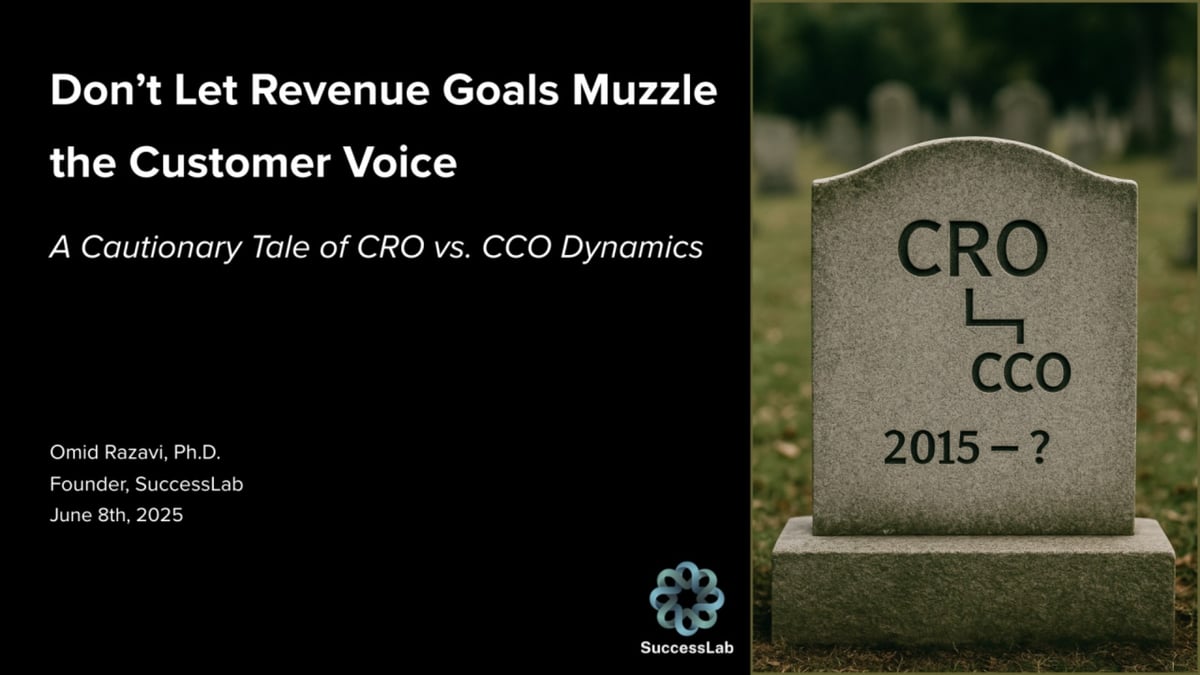Don’t Let Revenue Goals Muzzle the Customer Voice: A Cautionary Tale of CRO vs. CCO Dynamics

Omid Razavi
June 9, 2025
Summary
As Customer Success (CS) and Customer Experience (CX) leaders increasingly report to Chief Revenue Officers (CROs) — a trend accelerated by today's more measured SaaS growth — companies must pause and reassess. While this organizational shift may improve reporting efficiency and revenue accountability, it also risks diluting the authenticity and strategic influence of the customer voice. This article examines the evolution of the CRO and Chief Customer Officer (CCO) roles, the perceived benefits of consolidating CS and CX under revenue leadership, and the trade-offs that come with it. To achieve sustainable growth, businesses must design operating models that protect long-term customer relationships, rather than just delivering short-term financial gains.
The Rise of CROs and CCOs in SaaS
As SaaS business models evolved and customer relationships stretched well beyond the initial sale, two pivotal executive roles emerged to manage different parts of the customer lifecycle.
The Chief Revenue Officer (CRO) role gained momentum after 2008, as SaaS companies looked to streamline go-to-market functions. Sales, marketing, and eventually post-sales teams were brought together under a single leader accountable for revenue generation.
Around the same time, the Chief Customer Officer (CCO) began to take shape with a distinct mission: to maximize customer lifetime value by driving adoption, retention, advocacy, and continuous product feedback, ensuring customers achieve their desired outcomes.
For years, these roles coexisted in many high-growth SaaS organizations. However, today, amid increased focus on operational efficiency and consolidated accountability, there is mounting pressure to consolidate customer-facing functions under the CRO.
The Shift: Customer Success Under the CRO
According to the 2024 ChurnZero report, 33% of Customer Success leaders now report directly to the CRO, representing a 38% year-over-year increase. This trend is particularly evident in B2B SaaS, where expansion revenue, upsells, cross-sells, and renewals can account for 60–80% of annual recurring revenue (ARR) growth.

What’s driving this trend?
- Alignment: The move is often intended to create a “clean” handoff from pre-sale to post-sale and unify the customer lifecycle, but in practice, evidence of true continuity is mixed.
- Accountability: With the CRO owning growth targets, folding CS into their org promises a single point of accountability, “one throat to choke” or to cheer.
- Efficiency: One GTM org to rule them all; Sales, Marketing, and CS on a unified dashboard and reporting lines.
But with all that alignment and efficiency comes hidden risks.
What We’re Losing: Customer Truth and Strategic Insight
Let’s be clear—revenue is not the enemy. But when Customer Success and Experience teams are placed under a revenue leader without safeguards, organizations risk trading long-term insight and trust for short-term gains.
Here’s what can be lost in the process:
- Unfiltered Customer Signal - Reporting to the CRO can suppress critical feedback. Issues related to usability, unmet expectations, or declining customer sentiment may be softened or deprioritized, leaving the CEO and board without a clear view of systemic friction.
- Strategic Feedback Becomes Revenue Feedback - Customer input should fuel innovation and long-term improvements. Under a revenue lens, it’s often reframed to support sales narratives, reducing its value as a driver of product and experience evolution.
- Erosion of Trusted Advocacy - Customers confide in CS teams when they feel heard, not sold to. Conflating CS with Sales risks breaking that trust and weakening relationships built on transparency and support.
- Distorted Metrics - When CS is measured solely by Net Revenue Retention (NRR), upsells, or revenue outcomes, critical indicators such as onboarding success, product adoption, time-to-value, and customer sentiment are marginalized, despite being more predictive of future growth.
From Caretaker to Commercial Leader
One of the long-standing criticisms of CS/CX leaders is that they are often seen as “too soft,” valued for their empathy and service, but not for their commercial acumen. Some internalized this perception, acting as functional caretakers rather than commercial leaders and shying away from revenue metrics or strategic alignment with Finance. But that hesitation is no longer harmless or merely outdated; it’s a liability.
To be effective partners in growth, CS/CX leaders must fully own their commercial impact. That means embracing NRR and Gross Revenue Retention (GRR) targets, and collaborating with Finance to develop models that are boardroom-ready.
Modern CS leaders must understand cost-to-serve, customer acquisition payback, expansion drivers, and the margin profile of service motions. Without financial fluency and a business mindset, they risk being sidelined from key decisions, no matter how valuable their customer insights may be.
What’s the Playbook for CCOs?
As CS/CX leaders evolve into commercially fluent executives, they must go a step further, establishing themselves as strategic peers in the C-suite, whether they report to the CRO or CEO. That requires a clear playbook: embrace revenue accountability while championing a broader, enterprise-critical mandate.
Beyond renewals and expansion, CCOs carry a wide-ranging mandate that touches nearly every phase of the customer journey. Their scope includes onboarding and adoption, customer health monitoring, value realization, advocacy programs, voice-of-customer loops, journey mapping, retention strategy, executive engagement, escalation management, and cross-functional alignment with Product, Sales, and Marketing. These responsibilities shape not just customer outcomes, but also product innovation, brand perception, and long-term loyalty.
To reinforce their strategic value, CCOs must track and communicate their impact using metrics like time-to-value, Gross Revenue Retention (GRR), customer sentiment, engagement quality, and feedback utilization. With this data-driven credibility, they can stay aligned with revenue goals while preserving executive access and ensuring the customer voice influences the highest levels of decision-making.
Ultimately, CCOs must not be sidelined or absorbed. To drive sustainable growth, they need to stand as full strategic partners in the go-to-market engine, not simply extensions of Sales.
From Sales Leader to CRO: Climbing with Credibility
This responsibility also extends to aspiring CROs.
I recently spoke with a highly successful sales leader who told me that they were only considering CRO roles for their next move. When I asked why, and what made them ready, they paused and said, “It’s the next logical step. That’s where the ladder leads!”
That mindset, while common, reveals a misconception: viewing the CRO role as a reward for sales tenure, rather than as a leap in scope, accountability, and cross-functional leadership.
The most effective CROs are not just expert sellers. They are strategic architects of growth. They understand how marketing fuels demand, how product-market fit evolves, how adoption and retention impact expansion, and how to align post-sales delivery with long-term value creation. They collaborate deeply with Product, Marketing, Customer Success, and Operations, not just to close deals, but to shape a unified revenue engine.
Becoming a CRO isn’t just a vertical move up the ladder; it’s a horizontal expansion of perspective, responsibility, and influence.
How Marketing Earned Its Seat Back at the Table
Marketing faced a similar crossroads not long ago. Some companies, in the early years, moved Marketing under CRO oversight to better align messaging with revenue generation. While the intent was tighter coordination, the outcome often narrowed Marketing’s scope to demand capture and sales support.
Over time, marketing leaders pushed back—not by rejecting revenue accountability, but by clearly defining their broader, enterprise-critical mandate.
Modern CMOs own pipeline and demand generation, yes, but they also lead brand strategy, market positioning, product marketing, customer research, competitive intelligence, content and communications, analyst relations, digital and event strategy, partner marketing, and go-to-market alignment. These capabilities shape how the company is perceived, inform product direction, and drive sustainable growth.
By demonstrating both strategic influence and measurable business impact, Marketing reasserted itself as a peer to Sales. CMOs regained a direct reporting line to the CEO and reclaimed a seat at the executive table, next to the CRO, not reporting to them.
What’s the Alternative? Thoughtful Design and Balanced Leadership
If placing Customer Success under the CRO risks narrowing its mission, what’s a better path forward? The solution is to provide it with a clear mandate, equal standing, and visible accountability within the leadership team. Here’s what good design looks like:
- Executive-Level Ownership: CS/CX should be led by an executive who reports directly to the CEO or Chief Operating Officer (COO), particularly in companies that claim to be customer-led. This ensures the function isn’t reduced to a revenue expansion arm, but instead drives full accountability for customer experience, value delivery, and long-term impact.
- Dual Mandate, Not Split Identity: CS/CX leaders must own both commercial outcomes (Net and Gross Revenue Retention) and customer value metrics (adoption, time-to-value, and advocacy). Don’t force a choice between driving outcomes and driving revenue; they must do both.
- Strategic Influence, Not Just Pipeline Support: CS/CX should operate as a strategic pillar of the go-to-market engine, working in tandem with Sales, Product, and Marketing, rather than reporting to them. The CCO deserves the same voice in growth strategy as the CRO.
Stage-Appropriate Structure: In early-stage SaaS companies, CS often reports to the CEO to accelerate learning loops between product and customer. As companies scale, placing CS under a COO or CCO maintains neutrality and cross-functional balance. Only in well-aligned, mature orgs should CS roll into a CRO, and even then, only with safeguards: dotted-line reporting, board visibility, and a strong voice in strategic planning.
Ultimately, titles matter less than the authority to advocate for the customer. When that authority is limited, so is the company’s potential for long-term growth.
A CEO’s View of the Go-To-Market Machine
In today’s SaaS, CEOs don’t just need functional excellence; they need cross-functional cohesion. Success hinges on a unified leadership team across Marketing, Sales, Customer, and Product, each contributing a unique perspective but operating as a single go-to-market system.
The highest-performing organizations empower these leaders to act as strategic partners, breaking down silos, aligning around shared key performance indicators (KPIs), and speaking a common language rooted in customer value, rather than departmental metrics. Sustainable growth doesn’t come from hierarchy; it comes from joint accountability, seamless collaboration, and a relentless focus on delivering outcomes across the entire customer lifecycle.

The Path Forward: Protect the Customer Voice, Power the Business
Chief Revenue Officers play a vital role in orchestrating growth, but growth without listening erodes trust and sustainability. Customer Success was never meant just to reduce churn; it is designed to create value, build lasting relationships, and elevate the customer voice across the organization and into the C-suite.
As SaaS companies evolve toward more nuanced recurring, consumption-based, and outcome-driven models, preserving the strategic integrity of CS/CX is more critical than ever. These functions must not be buried under pipeline pressure or reduced to reactive functions. When the customer’s voice is sidelined, short-term wins too often come at the expense of long-term growth and loyalty.
The answer is thoughtfu, intentional design. Empower CS and CX leaders with commercial fluency, executive access, and a clear mandate to drive both customer experience and expansion. Only then can companies truly deliver sustainable, customer-led growth.
About the author:
Omid Razavi is the founder of SuccessLab and a global advocate for Customer Success, Service, and Support leadership. He has led executive forums and workshops across North America, Europe, and Asia, helping organizations align AI innovation with post-sales strategy and organizational design. Through SuccessLab and as host of the CCO Online and CSS Next virtual forums, he amplifies the voice of post-sales leaders, shaping strategic narratives and championing their critical role in driving customer value and long-term growth.
Like
Comments (0)
Popular
Dive in
Related
Blog
Thriving Amid Scaled Expectations: How AI and Leadership Are Redefining Customer Value
Nov 5th, 2025 • Views 1
Blog
Thriving Amid Scaled Expectations: How AI and Leadership Are Redefining Customer Value
Nov 5th, 2025 • Views 1

